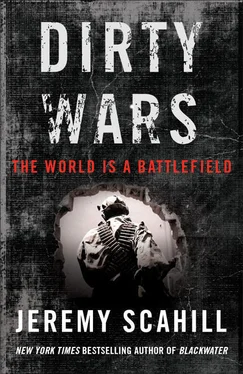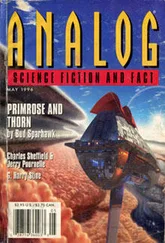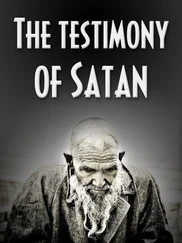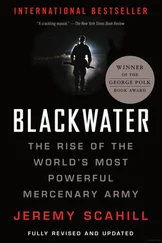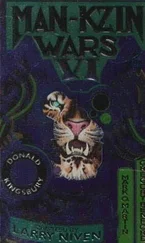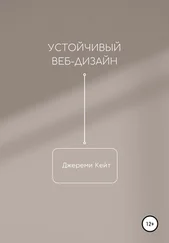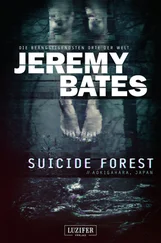The Special Operations Command also began working on a program for monitoring suspected or known insurgents. It was straight out of a sci-fi film. Known as “Continuous Clandestine Tagging Tracking and Locating,” or CTTL, it involved using advanced biometrics and chemistry to develop a long-range facial recognition program as well as a “Human Thermal Fingerprint” that could be isolated for any individual. They also used a chemical “bioreactive taggant” to mark people by discreetly swabbing a part of their body. The taggant would emit a signal that JSOC could remotely monitor, enabling it to track people 24/7/365. It was like a modern version of the old spook’s tracking devices made famous in films, where spies would weave them into an enemy’s clothes or place them on the bottom of a vehicle. The taggant allowed JSOC to mark prisoners and then release them to see if they would lead the task force to a potential terror or insurgent cell. Putting them on nonprisoners was a greater challenge, but it happened. The use of such technology, along with the accelerated pace of the killings and captures, would inspire President Bush’s declaration that “JSOC is awesome.”
While Iraq was vacuuming up most of the US counterterrorist resources, the White House and Pentagon continued on with their twilight wars elsewhere across the globe, and the war in Afghanistan festered, all but forgotten. Bin Laden was still at large, as were many of his top deputies, with Bush’s “Wanted Dead or Alive” pronouncement relegated to a source of scorn and a symbol of a failing yet spreading war. Taliban leader Mullah Omar was underground, while Pakistan was heating up and Somalia and Yemen were increasingly showing up on the counterterror radar.
As the US body count in Iraq increased as a result of the widening insurgency, President Bush would press commanders on how many people they had killed on any given day. The conventional generals would often balk at the question, but the answer from the JSOC crew was unequivocal. When asked how many Iraqis the task force killed in Iraq, McChrystal’s intelligence chief, Mike Flynn, replied, “Thousands, I don’t even know how many.” In Iraq, the task force had started to fulfill Rumsfeld and Cheney’s wildest dreams of what a streamlined, well-funded, secret force could do—and accomplish away from the prying eyes of Congress and the media, or even the CIA.
Although Rumsfeld and Cheney had already been circumventing the conventional military chain of command and coordinating directly with JSOC, they now had all the pieces of their puzzle in place. The task force that had been built up and refined in Afghanistan and Iraq was going to take its actions global and away from declared battlefields. McChrystal began establishing a network of JSOC liaison offices in a variety of Middle Eastern and other countries to avoid relying on—or working with—US embassies or CIA station chiefs. “The Department of Defense is very eager to step up its involvement in counterterrorism activities, and it has set its sights on traditional CIA operational responsibilities and authorities,” asserted Brennan, who at the time ran the National Counterterrorism Center. “Quite unfortunately, the CIA’s important lead role in many of these areas is being steadily eroded, and the current militarization of many of the nation’s intelligence functions and responsibilities will be viewed as a major mistake in the very near future.” In the wake of the WMD scandal in the lead-up to the Iraq War, veteran intelligence professionals were already concerned that the independence of the CIA’s analysis was being compromised to adhere to political agendas. With JSOC being used as a parallel intelligence operation to the CIA—and one with its own force to act free of independent review—the potential for abuse of substantial and secretive military power was significant.
Colonel Patrick Lang, who once ran the Defense Intelligence Agency’s global human intelligence operations, concurred with Brennan about the risks of Rumsfeld and Cheney’s innovations in the command structure. “When you made SOCOM a supported command rather than a supporting command, then you’ve freed [JSOC] up to do all kinds of things,” he said. “To do that kind of thing without coordinating with the US ambassador of that country, or with the host country’s government is just kind of banditry, really. I mean, you’re asking for retribution of some kind by somebody on your own turf, against your own people. It’s not a good idea, at all.”
Critics be damned, though, the JSOC Iraq model was about to go on tour. “You look at our Special Operations Forces, you have the ability to wage war, in a very low key way, and in a way that’s not going to command a lot of congressional oversight,” said Exum. The mindset, he said, was: “You have an empowered executive branch that more or less has license to wage war wherever it needs to, wherever it determines it needs to, worldwide. You’ve got this great hammer, and, you know, why not go hammer some nails?”
IN EARLY 2005, a behind-the-scenes scuffle broke out between the CIA, CENTCOM and the Pentagon over who should take the lead in targeting al Qaeda in Pakistan after some US intelligence reports suggested that al Qaeda’s number-two man, Ayman al Zawahiri, was believed to be attending a meeting in the tribal area of Bajaur in Waziristan. General McChrystal pushed hard for a JSOC raid to capture Zawahiri, and some CIA officials wanted him to do so without informing the US ambassador in Islamabad, Ryan Crocker. Anthony Shaffer said that he and US Special Operations planners had wanted to conduct such missions without informing the CIA, either. “We felt that there was a likelihood at some point that CIA would—either inadvertently or with knowledge—give the ISI information relating to what we were doing,” he told me. “The idea was, to be blunt about it, to go it alone. We felt that we could not trust the CIA or the Pakistanis, to any great degree.” He added: “There are just some targets the Pakistanis would never cooperate with us to get.”
The CIA, however, was well aware of this operation. Teams of Navy SEALs and Army Rangers in Afghanistan were actually preparing to board aircraft for the operation, which included as many as one hundred commandos, when the fighting among the CIA, CENTCOM and the Pentagon leadership became so contentious that the operation was grounded. A former CIA officer told the New York Times that as the raid was being debated, he had “told the military guys that this thing was going to be the biggest folly since the Bay of Pigs.”
Shaffer said that the rules for striking inside Pakistan had “changed dramatically” and “became much more restrictive to the point of where I think it was nearly impossible,” adding, “The format of the war changed under our feet.” General McChrystal, Shaffer said, “continued to push for authority to do things in Pakistan,” adding, “I know for a fact that there was a policy decision made at some level that restricted our ability to do cross-border operations to deal with the things that we all believed from my level was the real issue. Pakistan was the real issue, not Afghanistan.”
But then, in October 2005, Pakistan suffered a massive 7.6 magnitude earthquake. Some 75,000 Pakistanis died. Millions more were displaced. JSOC and the CIA took advantage of the disorder to fill the country with operatives, contractors and commandos, escaping requisite ISI background checks. According to journalists Marc Ambinder and D. B. Grady, the JSOC intelligence teams that entered Pakistan with the CIA had multiple goals, including the cultivation of informant rings to collect information on al Qaeda, as well as intelligence gathering related to how Pakistan transported its nuclear weapons. The elite US force also aimed to penetrate the ISI.
Читать дальше
